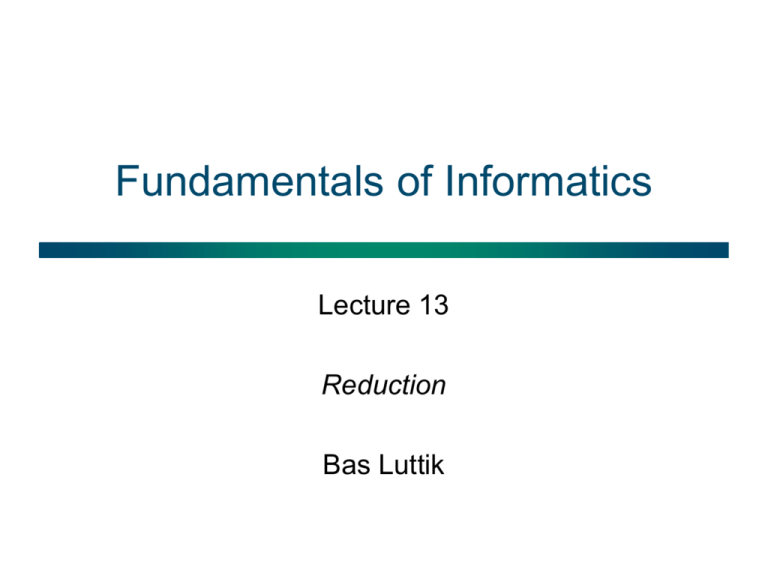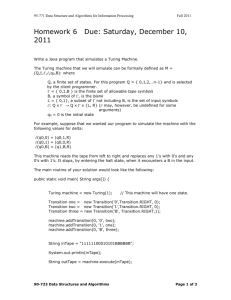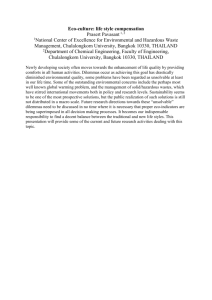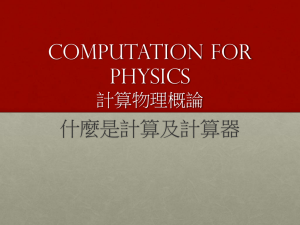Reduction and intractability
advertisement

Fundamentals of Informatics Lecture 13 Reduction Bas Luttik Decision problems Solvable there is an algorithm* that correctly answers all the questions of a decision problem Unsolvable there is no algorithm* that correctly answers all the questions of a decision problem A decision problem is a set of related yes/no questions, usually infinitely many. For instance, the primality decision problem (“given a natural number, decide whether it is prime”) consists of the questions: Is 0 prime? Is 1 prime? Is 2 prime? Etc. *By the Church-Turing thesis, we can always replace algorithm by Turing machine. Mother of unsolvable problems: halting Given a Turing machine M and an input sequence s, decide whether M’s computation on s will eventually terminate. description of M input sequence s for M T yes no outputs “yes” 1 if Mif M T reports 0 if M halts on s, and “no” not halt s s ifdoes M does not halt Other unsolvable problems: tiling Tile types: Is it possible to tile every room of arbitrary size with these tile types? Other unsolvable problems: tiling Tile types: Is it possible to tile every room of arbitrary size with these tile types? Other unsolvable problems: tiling Given a set of tile types, decide whether every room can be tiled using tiles of that type. The Tiling Problem is unsolvable! So: there is no computer program (and there will never be!) that decides whether arbitrary finite sets of tile types can tile rooms any size. Other unsolvable problems: matching Given two finite lists of words X and Y: 1 2 3 4 5 X abb a bab baba aba Y bbab aa ab aa a Is it possible to concatenate words in X such that the concatenation of the ‘corresponding’ words from Y yields the same word? 2 1 1 4 1 5 X a abb abb baba abb aba Y aa bbab bbab aa bbab a Other unsolvable problems: matching Given two finite lists of words X and Y: 1 2 3 4 5 X bb a bab baba aba Y bab aa ab aa a Is it possible to concatenate words in X such that the concatenation of the ‘corresponding’ words from Y yields the same word? Other unsolvable problems: matching Post Correspondence Problem: Given two lists of words, decide whether it is possible to concatenate corresponding words from either list to get the same word. Emil Post (1897-1954) The Post Correspondence Problem is unsolvable! Other unsolvable problems: polynomials Hilbert’s 10th problem: Given a polynomial P(x1,…,xn) in variables x1,…,xn with integer coefficients, decide whether the equation P(x1,…,xn) = 0 has a solution in integers. David Hilbert (1862-1943) Hilbert’s 10th problem is unsolvable! Note: A solution to the problem is an algorithm that works for arbitrary polynomials. There exist (straightforward) algorithms for subclasses of polynomials (e.g., for 2nd degree polynomials in one variable). Halting problem is Unsolvable Does X terminate on its own description? If X terminates on its own description, then T reports 1. So L goes into an infinite loop, and thus X does not terminate. Contradiction! If X does not terminate on its own description, then T reports 0. So L terminates, and thus X terminates. Contradiction! Both possible answers lead to a logical contradiction. Something must be wrong; it can only be our assumption that T exists. Conclusion: T does not exist; the halting problem is unsolvable. Logical structure of the argument ASSUME the halting problem is solvable DERIVE CONTRADICTION: Observe that if halting problem is solvable, then there must exist a Turing machine T that determines for every pair of a Turing machine M and input sequence s whether M terminates on s Use T to construct a paradox (i.e., the desired contradiction) CONCLUDE the halting problem is unsolvable Analogy: the Barber Paradox "The barber is a man in town who shaves all those, and only those, men in town who do not shave themselves." Who shaves the barber? If the barber shaves himself, then, according to the advert above, he is one of those men who do not shave themselves. Contradiction! If the barber does not shave himself, then, according to the advert above, he is one of those men who are shaved by the barber. Contradiction! Conclusion: there is no barber satisfying the requirements in the advert! To eliminate the paradox: move the barber out of town. Analogy: the Barber Paradox "The barber is a man in town who shaves all those, and only those, men in town who do not shave themselves." barber -> exTerminator, shaving -> terminating, man -> Turing machine "The exTerminator is a Turing machine that terminates on those, and only those, Turing machines that do not terminate on themselves." Question: Could we perhaps solve the halting problem by finding a solution outside the Turing machine formalism? Answer: Not if we accept the Church-Turing thesis. Logical structure of the argument Paradox requires self-referentiality: ‘problem domain’ = ‘solution domain’ ASSUME the halting problem is solvable DERIVE CONTRADICTION: Observe that if halting problem is solvable, then there must exist a Turing machine T that determines for every pair of a Turing machine M and input sequence s whether M terminates on s Use T to construct a paradox (i.e., the desired contradiction) CONCLUDE the halting problem is unsolvable The Tiling Problem Given a set of tile types, decide whether every room can be tiled using tiles of that type. What would it mean to solve it? There would have to exist a Turing machine (or algorithm) T such that: description of set of tile types T Decide if T admits tiling yes no outputs “yes” 1 if Mif set T reports halts s, and 0 if M of tileon types admits does not s tiling; “no”halt otherwise Logical structure of the argument ASSUME the halting problem is solvable DERIVE CONTRADICTION: Observe that if halting problem is solvable, then there must exist a Turing machine T that determines for every pair of a Turing machine M and input sequence s whether M terminates on s Use T to construct a paradox (i.e., the desired contradiction) CONCLUDE the halting problem is unsolvable Logical structure of the argument No self-referentiality! ‘problem domain’ ≠ ‘solution domain’ ASSUME the tiling problem is solvable DERIVE CONTRADICTION: Observe that if tiling problem is solvable, then there must exist a Turing machine that determines for every set of tile types whether every room can be tiled. How do we now get our contradiction? CONCLUDE the tiling problem is unsolvable Reduction Problem A Problem B A reduction from Problem A to Problem B consists of a general method (algorithm) for transforming every instance of problem A into an instance of problem B, together with a general method (algorithm) for transforming the B-solution of every transformed instance of problem A back into an A-solution of the original instance of problem A Then, if we have a solution for problem B, then we can effectively use it to solve problem A. Completing the square algorithm CSQ(a, b, c) Input: real numbers a, b, and c. Output: the (real) roots of the single-variable quadratic equation ax2 + bx + c = 0 1. 2. 3. 4. 5. 6. Divide each side by a Subtract c/a from both sides of the equation Add (b/2a)2 to both sides of the equation Write the left-hand side as a square (using x2 + 2hx + h2 = (x + h)2) Produce two linear equations by equating the square root of the left-hand side with the positive and negative square roots of the right-hand side Find the roots by solving the two linear equations Completing the square algorithm CSQ(a, b, c) Input: real numbers a, b, and c. Output: the (real) roots of the single-variable quadratic equation ax2 + bx + c = 0 1. 2. 3. 4. 5. 6. Divide each side by a Subtract c/a from both sides of the equation Add (b/2a)2 to both sides of the equation Write the left-hand side as a square (using x2 + 2hx + h2 = (x + h)2) Produce two linear equations by equating the square root of the left-hand side with the positive and negative square roots of the right-hand side Find the roots by solving the two linear equations Reduction for decision problems Problem A Problem B A reduction from decision Problem A to decision Problem B consists of two parts: 1. a general method (algorithm) for transforming every question of problem A into an question of problem B 2. an argument that the B-answer to every transformed A-question can be interpreted as a (correct) answer to the original A-question. (Sometimes Banswers need to be negated.) Note that if we have a solution for decision problem B and a reduction from A to B, then we can effectively use it to solve problem A. So: if B is (assumed to be) solvable and we can exhibit a reduction from A to B, then it follows that A is solvable too. Hence, if A is already known to be unsolvable, we get a contradiction! Logical structure of the argument It suffices to establish a reduction from a problem already known to be unsolvable (e.g., the halting problem) to the tiling problem. ASSUME the tiling problem is solvable DERIVE CONTRADICTION: Observe that if tiling problem is solvable, then there must exist a Turing machine that determines for every set of tile types whether every room can be tiled. How do we now get our contradiction? CONCLUDE the tiling problem is unsolvable From halting to tiling description of M, input sequence s for M Transform M,s to set of tile types T that admits tiling if, and only if, M does not halt on s Starting from the assumption that the T have tiling problemdescription is solvable,ofwe constructed a Turing machine that solves the halting problem. Contradiction! Decide if T admits tiling yes no Yes if tiling is possible No otherwise Yes if M halts on s No otherwise no yes From halting to tiling It remains to find a general method to transform M,s to suitable T We will not complete the proof by showing the general method here. But to give you an idea, we will illustrate it on the next few slides, by showing how the computation of an example Turing machine is simulated with a tiling, in a slightly modified setting. The Tiling Problem (slightly modified) Input: set of tile types and a starting tile Problem: decide whether the upper half of the infinite integer grid can be tiled using tiles of that type. Extra requirement: starting tile is placed somewhere on bottom row. With the following two slides we illustrate how an example Turing machine M together with an input sequence s is transformed into an instance of the modified tiling problem (a set of tile types together with a starting tile). Simulating TM computations with tilings Tape head movement Transition table: Tape: Starting tile Transitions Simulating TM computations with tilings Tape head movement Transition table: Tape: Starting tile Transitions The Modified Tiling Problem Input: set of tile types T and a starting tile t Problem: decide whether the upper half of the infinite integer grid can be tiled using tiles in T. Extra requirement: starting tile t is placed somewhere on bottom row. There exists an algorithm that associates with every description of a Turing machine M and input sequence s a description of a set of tile types T and a starting tile t such that: T, t admits tiling if, and only if, M does not halt on s From halting to tiling description of M, input sequence s for M Transform M,s to set of tile types T and starting tile t that admits tiling if, and only if, M does not halt on s Starting from the assumption that the description T, t modified tiling problem isofsolvable, we have constructed a Turing machine that solves the halting problem. Contradiction! Decide if T, t admits tiling yes no Yes if tiling is possible No otherwise Yes if M halts on s No otherwise no yes The Blank Tape Problem Exercise: Construct a Turing machine that, when started on a blank tape, halts with the sequence 0110 written on the tape, and the tape head on the left-most 0. (We don’t care what it does when started on a tape not entirely blank.) Now consider the blank tape problem: Given a Turing machine M, decide whether M’s computation will eventually halt if it is started on a blank tape. Reduce the halting problem to the blank tape problem to prove that it is unsolvable. Logical structure of the argument ASSUME the blank tape problem is solvable DERIVE CONTRADICTION: Observe that if blank tape problem is solvable, then there must exist a Turing machine that determines for every Turing machine whether it eventually terminates when started with a blank tape. Obtain contradiction by establishing a reduction from the halting problem to the blank tape problem CONCLUDE the tiling problem is unsolvable Mind the direction: we reduce from a problem already known to be unsolvable to the problem of which we want to establish unsolvability! Reduction description of M, input sequence s for M Transform description of M,s to description of M’ that first writes s and then runs M Starting from the assumption that the description of M’ we have blank tape problem is solvable, constructed a Turing machine that solves the halting problem. B Contradiction! yes no Yes if M’ halts on blank tape; No otherwise Yes if M halts on s No otherwise yes no The Blank Tape Problem for TMs The blank tape problem is unsolvable. Proof. Suppose that the blank tape problem is solvable; then there exists a Turing machine B that solves it (i.e., returns yes if its input sequence is a description of a Turing machine that terminates on a blank tape). Use B to construct a Turing machine T that runs according to the following algorithm: 1. Transform description of M and s into description of M’ that first writes s on its tape, moves to left-most non-blank, and then continues as M. 2. Run B on description of M’. 3. Answer yes if B answers yes; answer no if B answers no. Since B answers yes on the description of M’ if, and only if, M halts on s, and B answers no on the description of M’ if, and only if, M does not halt on s, it follows that T solves the halting problem. We have thus established a reduction from the halting problem to the blank tape problem. Contradiction! QED! Proof by reduction A reduction proof that a decision problem P is unsolvable consists of 1. The description of a general method to transform every question (input) for some other problem U, known to be unsolvable, to a question (input) for problem P. 2. An explanation of how the P-answer to every transformed Uquestion should be interpreted as an answer to the original Uquestion. 3. A conclusion stating that the presupposed solvability of P together with the reduction from U to P implies the solvability of U, and thus contradicts the unsolvability of U. Material Chapter 59 (see reader) presents a proof of the unsolvability of the Halting problem. Chapter 66 (see reader) sheds more light on the ChurchTuring thesis. Chapter 10 discusses intractable and unsolvable problems. Deadline: January 15, 2016








